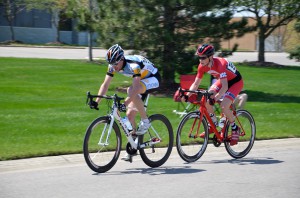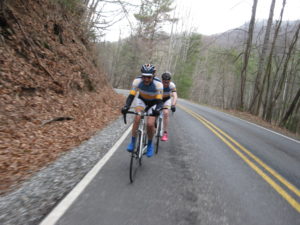By Nathan Frazier, Team OAM Now Cyclist
As cyclists, we have the opportunity to control a lot of factors in a race. We can control the bike, what the kit, the gear, and the pace. However, one thing we cannot change is wind, and wind is a huge factor in a race. A headwind can slow down an attacker, a side wind can cause a wreck, and a backwind can make the group pace skyrocket. So is wind an enemy, or an ally?
 Before talking about how wind affects a race, one must know what drafting is. Drafting is a process in which you position yourself out of direct wind gusts by means of other racers. Being out of the wind makes a huge difference, and it’s the reason why no one likes to lead or be in the rear of a pack. Positioning matters on wind direction as well. For example, one would stay behind another racer during a head wind, or on the opposite side of a racer with a side wind. Cycling gear is also designed to assist against wind, with light, specifically shaped frames to strange aero helmets for time trials.
Before talking about how wind affects a race, one must know what drafting is. Drafting is a process in which you position yourself out of direct wind gusts by means of other racers. Being out of the wind makes a huge difference, and it’s the reason why no one likes to lead or be in the rear of a pack. Positioning matters on wind direction as well. For example, one would stay behind another racer during a head wind, or on the opposite side of a racer with a side wind. Cycling gear is also designed to assist against wind, with light, specifically shaped frames to strange aero helmets for time trials.
Drafting isn’t just important in cycling, however. Even race car drivers depend on drafting to overtake other drivers, sometimes by a slipstream created from the high speeds of the cars producing a ‘stream’ of broken wind behind them. Speed skaters use this too, even though they are in an inclosed space. Drafting behind a skater can mean the difference of a second or first place finish in a sprint, and the same goes with a cycling finish. Those last hundred meters are often the most chaotic!
 Wind is a powerful factor in racing, and I learned this the hard way. Racing earlier this year, I found it difficult to stay with even the most moderate of paces. I was confused and discouraged, as I couldn’t find any reason to fall behind so much. I was training well, going to races for experience, and I didn’t lead at all during a race. So why was I getting dropped? My coach and father helped me reach the conclusion that, on an especially windy day when a huge gust took the life out of me, the wind was my foe. I had to learn to make it my ally. I practiced positioning with other cyclists during large group rides, making sure I was out of the wind’s direct influence. I found that I could hang on to groups more easily, and that I wasn’t as tired when a sprint ended.
Wind is a powerful factor in racing, and I learned this the hard way. Racing earlier this year, I found it difficult to stay with even the most moderate of paces. I was confused and discouraged, as I couldn’t find any reason to fall behind so much. I was training well, going to races for experience, and I didn’t lead at all during a race. So why was I getting dropped? My coach and father helped me reach the conclusion that, on an especially windy day when a huge gust took the life out of me, the wind was my foe. I had to learn to make it my ally. I practiced positioning with other cyclists during large group rides, making sure I was out of the wind’s direct influence. I found that I could hang on to groups more easily, and that I wasn’t as tired when a sprint ended.
Wind is now my ally in this situation. On your next group ride, pay attention to the wind, and your position in the pack to make wind your ally as well.
The post Drafting: Is Wind Your Friend or Foe? appeared first on Team Athletic Mentors.




 Our Hockey Site
Our Hockey Site Team AM
Team AM

